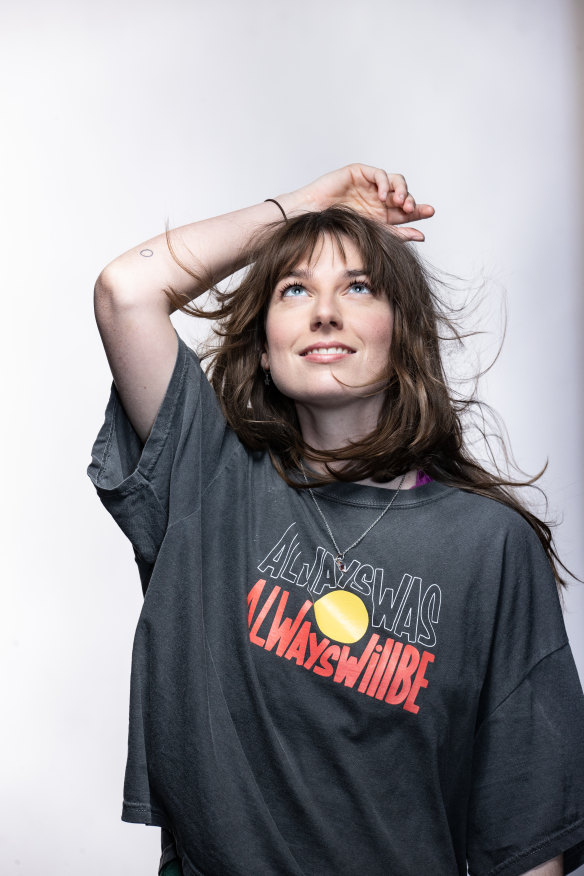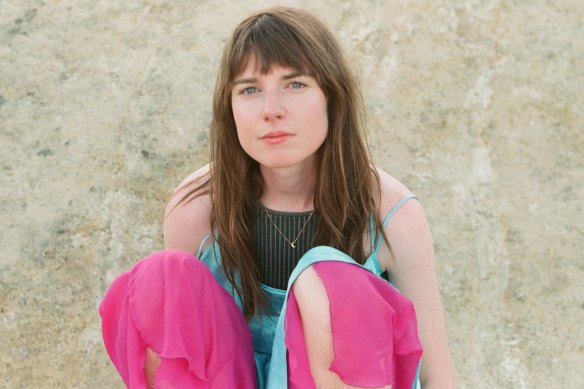By Jules LeFevre
Save articles for later
Add articles to your saved list and come back to them any time.
Angie McMahon arrived on stage at Sydney’s Metro Theatre not with a bang, but with a whisper. The packed-out venue had fallen silent after the yells of welcome, waiting for the initial blast of guitar or kick drum. But it didn’t come, as the Melbourne songwriter stood silently behind the microphone, taking a moment to breathe it all in.
“Thank you so much for being here,” McMahon told the crowd, voice barely hovering above a murmur. “That made me want to cry.”
A few scattered shouts of “I love you!” burst forth from the crowd, before McMahon offered a respectful Acknowledgment of Country and the first clear notes of Fireball Whiskey rang out. McMahon begins to sing – her rich, clear voice filling every corner of the space. Despite being a recent single, the crowd knows every word.
Since breaking out in 2017, Angie McMahon has become one of Australia’s most respected songwriters and in-demand performers.Credit: Simon Schluter
It’s a long-awaited return for the 29-year-old, who since breaking out in 2017 has become one of Australia’s most respected songwriters and in-demand performers, having sold-out shows across the country and secured support slots for some of the biggest artists in the world. Musically, McMahon stretches from whispered, intimate folk to vast and reaching indie rock, but all her songs draw from the same well: vulnerable, direct, soul-baring.
On this night, her set features plenty of old favourites – including breakthrough hit Slow Mover and the propulsive Keeping Time – but the purpose of this short theatre tour is to introduce McMahon’s highly anticipated second album, Light, Dark, Light Again.
Written during a period of turbulent mental health and self-reckoning, the new songs, such as the Bruce Springsteen-influenced Letting Go and the dark, twisted Mother Nature, sound cavernous in the small space. It’s also the first time they have been performed live, making it a clearly emotional night for her. Later in the show she pauses again, wiping away a few tears. “This is the crying show,” she jokes to the audience.
A few days later, on a cool and rainy Melbourne afternoon, McMahon is rugged up in a black jumper. “I felt really emotional before we even started playing,” she says. “I’ve just been really looking forward to being able to do that. It’s never happened to me before. I just started crying. I hadn’t even plugged my guitar in yet, and I just felt it.”
McMahon grew up in the leafy suburb of Alphington in Melbourne (“I usually tell people Fairfield because nobody knows Alphington,” she quips), the daughter of a Springsteen-loving father and a mother with a beautiful singing voice. McMahon struggles to remember a time when she didn’t want to be a singer.
“I was quite young when Missy Higgins’ The Sound of White came out,” she recalls. “That was a really big turning point in my life. I felt like [after] listening to that record and learning to play the songs, which I did a lot, I had a clear understanding of what I wanted to do with myself.”
She started piano lessons at the age of four, and after dinner every night she would wander off to the piano to bash playfully on the keys. “[My family] just let me go off and make noise after dinner. Like, ‘Angie’s yelling at the piano again’,” she says, laughing. “I’m so grateful they didn’t make fun of me for it.”
The noise-making eventually evolved into covers and scratchy, home-spun demos, which McMahon would record in her bedroom and upload to Facebook and YouTube. In 2013, a big break came: she was selected to support Bon Jovi on his tour of Australia after winning a Road to Discovery competition run by Telstra. It was a dream opportunity, but McMahon, ever a wise head on young shoulders, knew it was too soon.
“I was like, ‘I’m not ready for this. My songs are shit. I can’t really perform. I’m not really bringing anything to the stage other than being a timid, folkie singer-songwriter’,” McMahon told The Sydney Morning Herald’s Anthony Carew in 2018. “I knew I wasn’t good enough. I was worried, of course, that I was passing up some massive opportunity. But, sometimes you have to.”
Instead, McMahon finished her arts degree at the University of Melbourne and finally returned to music in 2017 with the chugging, bluesy track Slow Mover. An incisive songwriter, it was her voice that immediately commanded attention: deep and strong, with the ability to fly up the register, it earned her constant comparisons to powerhouses such as Florence Welch and k.d. lang.
Slow Mover, which landed at No. 33 in Triple j’s Hottest 100, was quickly tailed by equally successful singles Keeping Time and Pasta, with her debut album Salt arriving in 2019. McMahon played sold-out tours across the country, supported Pixies, Father John Misty, the Shins, and played a host of international gigs. It was a seemingly flawless start to a career, but making and releasing Salt had also forced McMahon to confront things she’d been pushing down. Namely, her ongoing struggle with her mental health.
“I very quickly had to recognise and talk about it,” McMahon says after a pause, leaning forward on her desk. “Maybe it came from doing interviews and being publicly perceived … I was having really intense anxiety and I developed a more complicated relationship with depression while releasing music.”
Angie McMahon on stage during her sold-out show at Melbourne’s Northcote Theatre in September.Credit: Young Ha Kim
The month Slow Mover was released, she was “crying more than I’ve ever cried”. She ended up going to see a therapist for the first time. “I became really paralysed by the state of my mental health,” she says. “I didn’t know what was coming, and what was coming were things that, up until that point, I’d just been able to deal with privately, and in my own time.”
About nine months after Salt was released, the COVID-19 lockdowns arrived. It had a devastating impact on the Australian music industry, but McMahon, exhausted from touring and needing space, felt a sense of relief in having the world come to a pause.
But it wasn’t long before McMahon was facing a series of personal reckonings, ones that would leave her completely unmoored and falling apart. Part of the catalyst, she says, was moving out of home for the first time, away from the comfort zone of her tight family unit.
“I came to accept that I was queer, which I had been hiding from myself for a long time,” she says. “I also understood that I had ADHD, which I had no idea about. These things that were present in me, and I hadn’t ever tackled the reality of them before. It just shifted my idea of my identity.”
In the midst of this, some of her personal relationships began cracking, she became seriously ill with glandular fever and her mental health began to spiral.
“I started to experience panic attacks I’d never had before, and I just completely lost control of my nervous system,” McMahon says. “I guess I thought that I had had control over it before, but I stopped understanding why my body was doing what it was doing, and I stopped being able to regulate myself on any level … I was just paralysed by fear and felt like I’d completely failed. I felt like I’d failed all the people around me.”
Angie McMahon battled depression and anxiety after the release of her first album, but her second album has helped her find “that note of hope”.Credit: Taylor Ranston
At times, McMahon could do little more than drag a mattress into her backyard and lie down, staring at the sky, watching the birds, trying to connect herself to a natural world that felt strong and hopeful.
The songs on Light, Dark, Light Again give shape to this period. They became a way for McMahon to pull herself out of the grief, to understand the depths of what had happened. But the album isn’t stuck at rock bottom. Rather, the songs grasp at hope, a result of McMahon using them to comfort herself, to give herself what she needed.
The record was pieced together slowly, surely. McMahon went into the studio a couple of times before abandoning it, lacking the confidence to see it through. Eventually, it came together through sessions with producer Brad Cook in North Carolina, and at home with Alex O’Gorman and Bonnie Knight.
Where Salt was pared back, Light, Dark, Light Again is expansive and cinematic: harmonies ricochet atop thundering drums, guitars build into walls of sound, and Angie’s voice stretches powerfully outwards. “I’ve been learning about letting go, how to do it without my claws scratching the surfaces,” she sings on the album’s standout Letting Go. “It’s OK, make mistakes,” she yells at the end, a mantra she repeats constantly when things get overwhelming.
Nature is a constant presence on the album, from the opening sounds of the river in Saturn Returning to the whispers of wind and trees at the very end. It’s become a spiritual connection to McMahon. “I was raised in a religious context where you pray to God and you learn from the Bible,” she reflects. “And I don’t practise any religion now, but I think I have transferred that root training to pray to something, be in ritual with something and see God. I transferred it to nature.”
In conversation, McMahon is thoughtful and generous, pausing often to gather her thoughts and try and untangle the knot of emotions as best she can. Having been confronted by the promotional rollout for Salt, I ask how she’s feeling this time around, carrying an album and a story that is so vulnerable.
“That’s a great question,” she smiles wryly. “It’s given me a lot of opportunities to practise what I am preaching, which is try and be gentle with yourself … but it’s hard, I’m quite tired.”
The album’s title is taken from the closing track on the record, aptly called Making It Through, with McMahon softly repeating the refrain while birdsong and cicadas flutter in the background. Things come to an end, the song offers, and then it begins again. The sun rises and falls. The world keeps turning.
“It felt like the story of the record in summary,” McMahon says. “I really love that it finishes on that note of hope.”
Angie McMahon’s new album Light, Dark, Light Again is released on October 27.
Find out the next TV, streaming series and movies to add to your must-sees. Get The Watchlist delivered every Thursday.
Most Viewed in Culture
Source: Read Full Article





